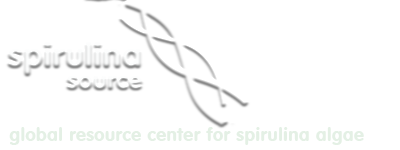REFERENCES AND ABSTRACTS BY HEALTH CATEGORY
Spirulina scientific reference library. Over 100 references covering 45 years of international research.
Click on PDF Download button for free pdf file.
![]() Current Status of Pharmacological Potentials of Phycocyanin. by Apurva Gupta et al. World Journal of Pharmaceutical Sciences ISSN (Print): 2321-3310; ISSN (Online): 2321-3086. 2016. India.
Current Status of Pharmacological Potentials of Phycocyanin. by Apurva Gupta et al. World Journal of Pharmaceutical Sciences ISSN (Print): 2321-3310; ISSN (Online): 2321-3086. 2016. India.
Phycocyanin (PC) is a blue, light harvesting pigment in cyanobacteria, rhodophytes and cryptophytes. It is one of the phycobiliproteins that forms phycobilisome- a light harvesting complex in cyanobacteria. PC is water soluble and strongly fluorescent. It has recently been exploited for its fluorescent and pharmacological properties. Moreover, its use as the healthy ingredient in cyanobacterial based foods and food additive is also gaining recognition due to the increasing awareness of harmful effects of synthetic compounds and inclination of community towards the usage of natural products. More recently, PC content of phytoplankton has proved to be a useful index for the amount of cyanobacteria in water sample. The present review focuses on recent developments in clinical, dietary and fluorescent applications of phycocyanin.
![]() Purified C-phycocyanin from Spirulina platensis (Nordstedt) Geitler: a novel and potent agent against drug resistant bacteria. by Dronamraju V. L. Sarada et al. University of Madras. World J Microbiol Biotechnol (2011) 27:779–783 DOI 10.1007/s11274-010-0516-2. 2011. India.
Purified C-phycocyanin from Spirulina platensis (Nordstedt) Geitler: a novel and potent agent against drug resistant bacteria. by Dronamraju V. L. Sarada et al. University of Madras. World J Microbiol Biotechnol (2011) 27:779–783 DOI 10.1007/s11274-010-0516-2. 2011. India.
The experimental data on the study of the anti-bacterial activity of purified phycocyanin, a protein-bound pigment isolated from blue-green alga, Spirulina platensis (Nordstedt) Geitler, Oscillatoriaceae are generalized and it was shown that phycocyanin was able to markedly inhibit the growth of drug resistant bacteria Escherichia coli, Klebsiella pneumoniae, Pseudomonas aeruginosa and Staphylococcus aureus while, no activity was recorded in Acinetobacter baumanii and Enterococcus durans, this is the first report of the activity of purified C-phycocyanin against drug resistant bacteria. The possible use of phycocyanin as a drug with associated antibacterial activity is discussed.
![]() Clinical Potential of Spirulina as a Source of Phycocyanobilin. by Mike F. McCarty. NutriGuard Research, Encinitas, California. JOURNAL OF MEDICINAL FOOD J Med Food 10 (4) 2007, 566–570 USA.
Clinical Potential of Spirulina as a Source of Phycocyanobilin. by Mike F. McCarty. NutriGuard Research, Encinitas, California. JOURNAL OF MEDICINAL FOOD J Med Food 10 (4) 2007, 566–570 USA.
ABSTRACT Recent research reveals that free bilirubin functions physiologically as a potent inhibitor of NADPH oxidase activity. The chromophore phycocyanobilin (PCB), found in blue-green algae and cyanobacteria such as Spirulina, also has been found to be a potent inhibitor of this enzyme complex, likely because in mammalian cells it is rapidly reduced to phycocyanorubin, a close homolog of bilirubin. In light of the protean roles of NADPH oxidase activation in pathology, it thus appears likely that PCB supplementation may have versatile potential in prevention and therapy—particularly in light of rodent studies demonstrating that orally administered Spirulina or phycocyanin can exert a wide range of anti-inflammatory effects. Until PCB-enriched Spirulina extracts or synthetically produced PCB are commercially available, the most feasible and least expensive way to administer PCB is by ingestion of whole Spirulina. A heaping tablespoon (about 15 g) of Spirulina can be expected to provide about 100 mg of PCB. By extrapolating from rodent studies, it can be concluded that an intake of 2 heaping tablespoons daily would be likely to have important antioxidant activity in humans—assuming that humans and rodents digest and absorb Spirulina-bound PCB in a comparable manner. An intake of this magnitude can be clinically feasible if Spirulina is incorporated into “smoothies”. Such a regimen should be evaluated in clinical syndromes characterized and in part mediated by NADPH oxidase overactivity in affected tissues.
Antitumoral agents containing phycobilin- also used to treat ulcers and hemorrhoidal bleeding.
by Dainippon Ink & Chemicals and Tokyo Kenkyukai. 1983. Patent 58065216 A 830418. Japan.
Effect of spirulina on the renal toxicity induced by inorganic mercury and cisplatin.
by H. Fukino, et al. 1990. Pub. in Eisei Kagaku, 36:5, 1990. Japan.
Kidney toxicity caused by mercury was suppressed by feeding spirulina to rats. A water soluble extract of spirulina, containing phycocyanin, the natural blue pigment, was examined. Renal (kidney) toxicity in rats caused by para-Aminophenol (pain reliever) and Cisplatin (anti-cancer) was significantly reduced by the phycocyanin extract of spirulina. Researchers concluded that phycocyanin plays a major role in the protective effect of spirulina against renal failure caused by mercury and pharmaceutical drugs, and that spirulina might be applicable to the reduction of general renal disfunction.
Effects of polysaccharide and phycocyanin from spirulina on peripheral blood and hematopoietic system of bone marrow in mice.
by Zhang Cheng-Wu, et al.. April 1994. Nanjing Univ. China. Pub. in Proc. of Second Asia Pacific Conf. on Algal Biotech. Univ. of Malaysia. China.
C-phycocyanin and polysaccharide were isolated and purified from spirulina. By using the techniques of colony forming unit-erythroid (CFU-E) culture of fetal liver cells in mice in vitro, C-phycocyanin was found to possess high erythropoietin (EPO) activity. The effects of polysaccharide and phycocyanin on the periphyeral blood and bone marrow hematopoietic stem and progentitor cell in normal, irradiated and anemic mice were studied. These studies demonstrate the unique capacity of C-phycocyanin and polysaccharide to influence the differentation and proliferation of committed hematopoietic progenitor cell. Stimulated recovery by C-phycocyanin and polysaccharide was observed in leukocyte and bone marrow nucleated cell counts and the number of CFU-GM colony formation in mice after single whole-body gamma-ray irradiation. The C-phycocyanin and polysaccharide can lower the anemic degree of mice combined with treatment of gamma-ray irradiation and benzohydrazine hydrochloric acid peritonerl injection.




